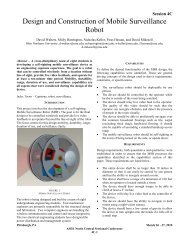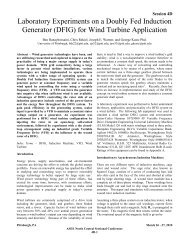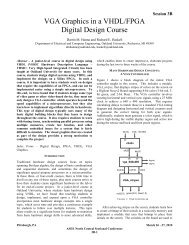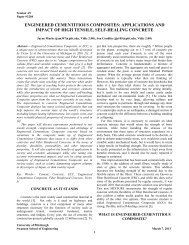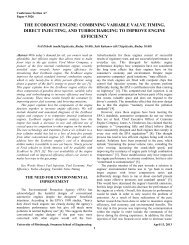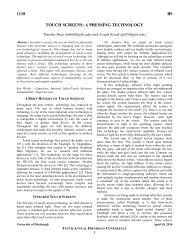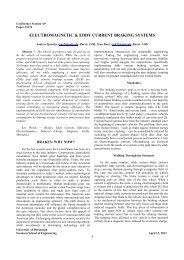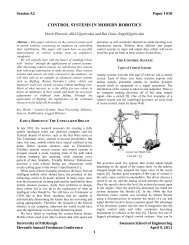use of digital checking fixtures and scanning techniques for reverse ...
use of digital checking fixtures and scanning techniques for reverse ...
use of digital checking fixtures and scanning techniques for reverse ...
Create successful ePaper yourself
Turn your PDF publications into a flip-book with our unique Google optimized e-Paper software.
Technique StepsFor this project an ATOS II white light scanner was <strong>use</strong>d toscan part geometry. [3] Once scanned, the surface geometry<strong>of</strong> a part is stored inside the attached s<strong>of</strong>tware. The ATOSs<strong>of</strong>tware allows a <strong>use</strong>r to divide up the scanned surface intosections. Too accurately model components in this way,sections along the X, Y <strong>and</strong> Z axis were made at fivemillimeter increments. An example <strong>of</strong> the spring sectionsalong the X-axis can be seen in Figure 2. In this figure thesections are overlaid on the part. When these sections areoverlaid on top <strong>of</strong> one another the entire part can be seen inthree dimensions. This is the starting point to this <strong>reverse</strong>technique.Figure 2Scan Sections Overlaid on ModelThe second step in creating the <strong>digital</strong> fixture was tolocate <strong>and</strong> identify the main datum reference points, then tocreate a three dimensional solid primitive to act in its place.In the case <strong>of</strong> the leaf spring, these points were the two ends<strong>of</strong> the spring <strong>and</strong> the top assembly mounts. All three <strong>of</strong>these primary points are bolt locations <strong>and</strong> regardless <strong>of</strong> theamount <strong>of</strong> deflection, these points will always be bolted inthese locations. An example <strong>of</strong> the described location canbe seen highlighted in Figure 3.Session 3Bboth a known size <strong>and</strong> had their geometry captured in allthree scans. An example <strong>of</strong> the finished first step can beseen in Figure4.Figure 4Primitive Cylinders with Spring <strong>for</strong> ReverenceThe third step in creating the fixture was to locate <strong>and</strong>represent secondary datums. In the springs case thesecondary datum would be where surfaces <strong>of</strong> the springwould come in contact with known surfaces <strong>of</strong> the truck.For example the leaf spring included a mounting platewhich not only rein<strong>for</strong>ced the bolt <strong>for</strong> the center axle mountbut also came in full contact with the axle itself. Also, twomounting plates, which are perpendicular to their mountingbolts at either end <strong>of</strong> the spring, were located. These arepoints which, like the bolts from the first step, will neverchange being in contact. However they are not as critical asthe bolt locations beca<strong>use</strong> there have larger variances. Thesesurfaces can shift <strong>and</strong> slide depending on the amount <strong>of</strong>deflection <strong>and</strong> how they were assembled. For example theends <strong>of</strong> the spring will bolt to the frame <strong>of</strong> the vehicle <strong>and</strong>prevent the spring from translation along the X, Y, <strong>and</strong> Zaxis. The surface <strong>of</strong> the vehicle frame, that the spring isbrought up against, prevents translation in only the Z axis<strong>and</strong> prevents rotation. Beca<strong>use</strong> the surface allows <strong>for</strong> alarger degree <strong>of</strong> translational movement <strong>and</strong> is not as criticalto the overall design intent, as the bolts, the surfaces are asecondary reference. After locating these points, they wererepresented in the CAD model by solid surfaces which thespring primitive would be joined against using matecomm<strong>and</strong>s. An example <strong>of</strong> the third step can be seen belowin Figure 5.Figure 3Primary Datum LocationsThese points represented the primary datum points. Theprimitives where made as cylinders, which represented thebolts that affix the spring in reality. All three <strong>of</strong> the bolts areFigure 5Primary <strong>and</strong> Secondary Datums with Spring <strong>for</strong> ReferenceThe final step in creating the fixture was to import thescanned sections <strong>of</strong> the deflected leaf spring into the fixturemodel. The imported sections were transferred into themodel as an IGES <strong>for</strong>mat. The points were then overlaidPittsburgh, PA March 26 - 27, 2010ASEE North Central Sectional Conference3B-3




